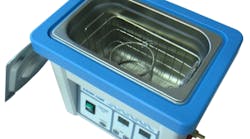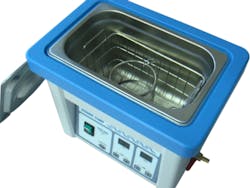Thursday Troubleshooter: Lid on or off the ultrasonic cleaner while running?
Nearly everyone has problems and concerns on the job, and sometimes you're just too close to a situation to solve something yourself. Share your concerns with Team Troubleshooter, and the experts will examine the issues and provide guidance. Send questions to [email protected].
__________________________________________________________________________________________________________________________________
QUESTION: We have a new hygienist in our practice who continuously leaves the top off of the ultrasonic cleaner while it’s running (with dirty instruments inside). We have asked her to please close the lid, but to no avail. I have been trying to find literature regarding the aerosol that is produced hoping to convince her through education (she won’t take my word for it) but I can’t find any. I even contacted a manufacturer who told me it’s 50/50 as to the importance of keeping the top on the ultrasonic cleaner. Perhaps I’m just being a “germaphobe,” but I would appreciate any input, if not for her sake, at least for my peace of mind! Thank you!
ANSWER FROM NOEL KELSCH, RDHAP,Hy-Ginx:
First and foremost, an ultrasonic bath falls under the Food and Drug Administration as a medical device. Each medical device has instructions for use (IFU) that accompanies it. Those instructions for use in the medical setting are not a suggestion, they are a requirement. All employees must be trained about the instructions for use, and must follow them. The instructions for use must be followed each and every time the device is used. (See emergency.cdc.gov/han/han00382.asp.)
In looking at the instructions for use for this medical device I looked at four different products. Every single product stated that you must have the lid before turning on the device. Not a suggestion—a requirement. One instruction stated, “Your machine should be operated with lid closed in order to prevent excess emission of noise and aerosols.” Another went even further and stated, “The lid should be kept on the ultrasonic cleaner while in operation. The lid is for the protection of the operator and in medical applications for patients also. It prevents aerosols generated during the cavitation process from dispersing and contaminating the reprocessing environment. In addition, the lid reduces the noise levels created during the ultrasonic cycle and helps to maintain the heat of the cleaning fluid in the tank.” Those aerosols can contain harmful disease-causing organisms. They can put both the staff and patients at risk.
But let’s take it a step further. How long have we known this? A really long time! I have an article from when I attended assisting school in 1975 that states the facts and science behind this requirement well. The article is titled, “Bacterial Aerosolization from an Ultrasonic Cleaner” by Turner, Wilkins, and Craddock. It appeared in the Journal of Microbiology, and it made me have respect for the ultrasonic. Not only is it amazing at removing debris from instruments, but it can be a very big risk in the wrong hands. The findings have stayed with me these many years.
The article delineates three things that we all need to remember:
1. Ultrasonic devices used for cleaning instruments were found to produce a significant microbial aerosol.
2. Ultrasonic cleaners can be used safely and airborne contamination from this source can be minimized.
3. Minimize contamination by daily cleaning of the solution tank, adding a germicide to the cleaning solution, and placing a cover over the tank while cleaning is in progress.
So, what do I know? I did a test with my son, Brice Kelsch, while he was attending Brooks Institute of Photography. Please note this was not a peer-reviewed test but rather an information gathering test for my own insight. We used time lapse photography.
We first did lid off. The overspray reached six to eight feet, depending on the size of the ultrasonic unit we used. The 11-liter tank we used reached an average of eight feet and the three-liter reached an average of six feet. With the lid on and the unit wiped dry there were no surrounding aerosols visible with the camera.
ANSWER FROM DEBRA ENGELHARDT NASH,Speaker, Trainer, Igniter:
I’d like to know, what was the training protocol for your new hygienist? So often offices hire new employees and because they have “experience,” the assumption is made that no further training is required. It may be possible that her previous office’s protocol was to leave the lid off of the ultrasonic and she has grown accustomed to that standard. Is it a written office standard to keep the top on the ultrasonic cleaner, and was the written office standard reviewed with the new hygienist?
Does her supervisor have the authority to give her feedback about her performance and her role in the practice? This is the person who needs to approach her to discuss office standards and expectations and whether additional training is required. Avoid having the dental team gang up on this person and make her feel picked on.
If you’re going to speak to her, here is a nice approach that will help avoid laying blame: “Sally, I have a problem and I need your help. When the top is off of the ultrasonic cleaner during the cleaning cycle, I’m concerned about the aerosol scatter.”
Review the responsibilities of training new employees, and be sure you have a written checklist that includes your office protocol for sterilization. Show new team members all of the office equipment and armamentarium and the proper maintenance and handling of these items in accordance with your office protocol.
RECENT TROUBLESHOOTERS
Snarky Facebook comments and HIPAA violations
Dentist asking for illegal assistance has dental assistant worried
Different codes for zirconia crowns vs. e.max crowns?
Don't be shy! If YOU have a tough issue in your dental office that you would like addressed, send it to [email protected] for the experts to answer. Remember, you'll be helping others who share the same issue. Responses will come from various dental consultants, as well as other experts in the areas of human resources, coding, front office management, and more. These folks will assist dental professionals with their various issues on DentistryIQ because they're very familiar with the tough challenges day-to-day practice can bring.
All inquiries will be answered anonymously each Thursday here on DIQ.







